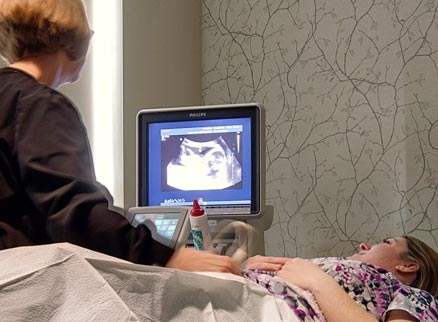Ultrasound
YOUR ULTRASOUND AT DIAGNOSTIC IMAGING CENTERS
 Ultrasound imaging, also called sonography, is an amazing way of seeing the structure and function of the body using high frequency (but inaudible) sound waves. Sound waves are transmitted from special transducers or probes into the body part being examined.
Ultrasound imaging, also called sonography, is an amazing way of seeing the structure and function of the body using high frequency (but inaudible) sound waves. Sound waves are transmitted from special transducers or probes into the body part being examined.
These sound waves then bounce off and/or go through the organs of the body, returning to the transducer. The returning sound waves are converted into images by special computers and displayed on a screen instantly.
Being able to view the images instantly or in real time affords advantages in looking at body parts in any position needed and in assessing movement. Looking right where you hurt is easily done!
Special transducers can be used to obtain 3 dimensional images of different structures, most frequently of the female pelvic organs and fetuses. Certain structural changes are best shown when viewed in 3D, including things like uterine malformations or masses and fetal facial defects.
Doppler ultrasound is a special technique based on the principle of the Doppler effect, that is the change in frequency of sound with movement (think train horn!). This allows us to visualize and assess blood flow in blood vessels and solid tissues.
Assessing the fetus during pregnancy may be the most familiar ultrasound test, and it has indeed revolutionized the practice of obstetrics. Fewer maternal and fetal deaths can certainly be attributed to the use of ultrasounds during pregnancy, allowing us to quickly assess for abnormal fetal position, risk of bleeding from abnormal placental position and fetal anatomy.
Ultrasound has uses throughout the body, from looking at the neck vessels for narrowings in those at risk of stroke, evaluating breast masses, looking for gallstones, assessing liver blood flow in cirrhosis, evaluating the uterus and ovaries, finding the source of scrotal pain to assessing tendons and muscles for tears. Most body parts can be evaluated with the exception of the adult brain – the skull is too thick for the sound waves to penetrate – and the lungs- air reflects the soundwaves.
Ultrasound is a highly sophisticated, safe, and painless exam that can help in screening for diseases, like abdominal aortic aneurysm or breast cancer, or in diagnosing the source of your symptoms, like abdominal pain. Our specially trained staff will work to make sure you are comfortable and your questions are addressed.
Ultrasound Preparations
Some ultrasound procedures have specific preparation instructions. You will be informed of these instructions at the time of scheduling.
For example, fasting overnight is necessary for abdominal ultrasounds. If you are scheduled for a pelvic or obstetrical exam, you will be instructed to drink 32 ounces of clear fluid one hour prior to your exam and not to urinate. While uncomfortable, a full bladder helps to enhance the ultrasound image of the pelvic organs.
What to Expect
You will lie on an examination table next to the ultrasound scanner. A special, warmed, water-based gel will be applied to the area of your body to be examined.
The ultrasound technologist will use a probe (or transducer) and slowly guide it across your skin in the area to be examined. For some studies, images will also be taken with you sitting or standing. Most exams are fairly quick, taking anywhere from 20 to 30 minutes.
TIPS FOR AN EXCELLENT ULTRASOUND
- Relax. Having an ultrasound exam is easy, quick and interactive!
- Ultrasounds can be done on any age patient, on almost any body part. Some studies require a prep before we see you – make sure to ask for specific instructions at the time of scheduling.
- Wear comfortable clothing – you may be asked to change into a gown for some exams.
- Ultrasound uses no ionizing radiation and requires no injections. Easy and amazing – that’s what we call it!





